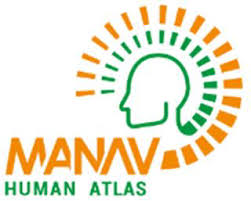MANAV : Human Atlas Initiative 17/05/2019 – Posted in: Daily News – Tags: biotechnology, Human Atlas, MANAV
MANAV : HUMAN ATLAS INITIATIVE
For: Preliminary & Mains
Topic covers: MANAV initiative- its objective & importance, Applications, Project details
News Flash
For the first time, Indian scientists will be mapping every single tissue of the human body to have deeper understanding of the roles of tissues and cells linked to various diseases.
Department of Biotechnology (DBT) launched MANAV : Human Atlas Initiative, towards improving knowledge on human physiology.
MANAV: Human Atlas Initiative
- It is a project which aims at creating a database network of all tissues in the human body from the available scientific literature.
- The programme will involve gaining better biological insights through physiological and molecular mapping, develop disease models through predictive computing and have a wholistic analysis and finally drug discovery.
- Project undertaken by two institutions in Pune – National Centre for Cell Science (NCCS) and Indian Institute of Science, Education and Research (IISER), Pune.
- It is a project that involves scientific skill development for annotation, science outreach along with handling big data.
Why is MANAV important?
- This platform will impart key skills to the student community to read classified scientific literature, on individual tissue-basis, and perform annotation and curation.
- This collated data can be useful for both future researchers and parallelly, to the clinicians and drug developers, who finally handle human bodies in disease conditions.
- Currently, researchers and students have had little or no expertise in reading scientific literature and develop or build further information on the same.
What are the applications of information generated through MANAV?
The aim of the project remains to understand and capture the human physiology in two stages – in a normal stage and while in a disease stage. Such a database on individual tissues, once ready, can come handy in tracing the causes of a disease, understanding specific pathways and ultimately decode the body’s disease stage linked to tissues and cells.
The teams will also study any potent elements or molecules that have never been used in the form of drugs, to target the specific cells or tissues.
Who can participate in this project?
The project can be signed up by students who are in their final year graduation and above. Students from the fields of biochemistry, biotechnology, microbiology, botany, zoology, bioinformatics, health sciences, systems biologists, pharmacologists and data sciences can associate with this project.
Even participants having a science background but not necessarily involved in active scientific research can be part of this network. The MANAV team has encouraged colleges and universities to register as teams and work in this project.
Department of Biotechnology (DBT)
- It is an Indian government department under the Ministry of Science and Technology.
- The department is responsible for administrating development and commercialisation in the field of modern biology and biotechnology in India.
- It was set up in 1986.
- In December 2015, the Department of Biotechnology launched the National Biotechnology Development Strategy 2015–2020 programme. The stated aim of the programme is to intensify research in the fields of vaccines, human genome, infectious and chronic diseases, crop science, animal agriculture and aqua culture, food and nutrition, environmental management and technologies for clean energy.
MANAV
MANAV initiative aims to create a comprehensive and integrated human map by assimilating all the known macro-level and micro-level information from scientific literature and public databases.
The proposed human map refers to a computational representation, which is envisaged to capture human physiology in natural and diseased state. This map will provide knowledge in holistic fashion from inter-organ dependencies to intra-organ, tissue level, cell and sub-cellular level biological reactions. Such representation is an important tool and can serve as analogous to the ‘human reference genome’.
MANAV would have applications such as: patient-specific support for medical/treatment decisions, understanding of pre-clinical and clinical assessment of healthcare products and personal health forecasting. Moreover, it will also help identify gaps in the current biological knowledge, which could be the basis for future studies and policies.
Source: Indian Express
You can follow us on LinkedIn and for more updates related to UPSC IAS Preparation, Like our Facebook Page and subscribe our Diligent IAS Youtube Channel
Also Read Related Daily News
- India International Institute of Democracy and Election Management (IIIDEM)
- Asiatic lion : Entire Genome sequencing

